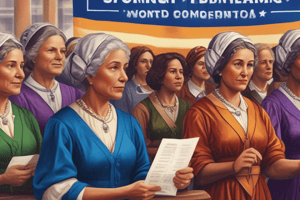Podcast
Questions and Answers
Which of the following best describes the primary objective of the Seneca Falls Convention's 'Declaration of Sentiments'?
Which of the following best describes the primary objective of the Seneca Falls Convention's 'Declaration of Sentiments'?
- To advocate for the prohibition of alcoholic beverages nationwide.
- To address a list of grievances against the American government, with women's suffrage as a key issue. (correct)
- To ensure women's participation in World War I as factory and office workers.
- To establish new guidelines for gender-inclusive language in political discourse.
How did the involvement of the United States in World War I influence the women's suffrage movement?
How did the involvement of the United States in World War I influence the women's suffrage movement?
- It caused a division within the women's suffrage movement, as some women prioritized war efforts over suffrage activities.
- It led to increased opposition from industrialists who feared women would support the abolition of child labor.
- It had no significant impact on the women's suffrage movement.
- It provided women with opportunities to enter the workforce, demonstrating their capabilities and contributing to a shift in public opinion. (correct)
What was a primary concern of the anti-suffrage movement regarding women's right to vote?
What was a primary concern of the anti-suffrage movement regarding women's right to vote?
- That women would seek equal pay for equal work, disrupting existing economic structures.
- That women would prioritize political involvement over domestic responsibilities.
- That it would lead to the destruction of the family and the promotion of socialism. (correct)
- That women would make alcoholic drinks illegal.
Which statement best reflects Elizabeth Cady Stanton's view on women's rights beyond suffrage?
Which statement best reflects Elizabeth Cady Stanton's view on women's rights beyond suffrage?
How did the passage of the Nineteenth Amendment in the United States compare to the progress of women's suffrage in other countries?
How did the passage of the Nineteenth Amendment in the United States compare to the progress of women's suffrage in other countries?
What factor explains the significant time and effort required to achieve women's suffrage and gender equality?
What factor explains the significant time and effort required to achieve women's suffrage and gender equality?
Why were brewers and distillers largely opposed to women's suffrage?
Why were brewers and distillers largely opposed to women's suffrage?
What is the main goal of using gender-inclusive language?
What is the main goal of using gender-inclusive language?
Which event immediately preceded President Woodrow Wilson's support for women's suffrage?
Which event immediately preceded President Woodrow Wilson's support for women's suffrage?
What does the fight for women's suffrage suggest about how political reforms are achieved, according to the content?
What does the fight for women's suffrage suggest about how political reforms are achieved, according to the content?
Flashcards
Women's Suffrage
Women's Suffrage
The right for women to vote, a key goal of women's activist groups in the US.
Anti-Suffrage Groups
Anti-Suffrage Groups
Organizations and individuals who opposed granting women the right to vote.
Nineteenth Amendment
Nineteenth Amendment
Granted American women the right to vote in 1920.
Gender-Inclusive Language
Gender-Inclusive Language
Signup and view all the flashcards
Popular Pressure
Popular Pressure
Signup and view all the flashcards
Seneca Falls Convention
Seneca Falls Convention
Signup and view all the flashcards
Elizabeth Cady Stanton
Elizabeth Cady Stanton
Signup and view all the flashcards
Study Notes
- 2020 is the 100th anniversary of women's suffrage in the U.S.
Historical Context of Voting Rights
- Initially, voting was restricted to men with property in most American states
- Eventually, all men gained the right to vote, but women were excluded
- Women were viewed as unfit or too unintelligent to vote
The Women's Suffrage Movement
- Women formed activist groups and organized conventions to fight for their rights
- The 1848 Seneca Falls convention produced a 'Declaration of Sentiments' that listed grievances against the American government, with women's suffrage as the primary demand
- The movement was not solely about voting rights, but also about achieving equality in other areas, demonstrated by Elizabeth Cady Stanton's desire for equal pay
Opposition to Women's Suffrage
- Not all women supported universal suffrage
- Anti-suffrage groups believed politics were corrupt and women should not participate
- They feared women acting like men would destroy the family and promote socialism
- Typically upper-class white women were afraid of losing privileges if the poor gained rights
- Brewers and distillers feared women would ban alcohol due to the women's movement's fight against alcoholism
- Industrialists believed women would support the abolition of child labor
The Nineteenth Amendment
- The National American Woman Suffrage Association was founded in 1890, protesting the exclusion of women
- U.S. entry into World War I in 1917 changed the landscape, as women filled essential roles in factories and offices
- In 1918, President Woodrow Wilson acknowledged women's contributions to the war effort
- The Nineteenth Amendment was passed in 1920, granting universal suffrage
- The U.S. joined other nations like New Zealand (1893) and Australia (1902) in granting women the right to vote
- Some nations required women to fight for many more decades to be able to vote
Language and Social Activism
- American society and many others favor men politically, economically, and culturally
- Even languages can have male bias
- The European Parliament issued guidelines to change discriminatory terms "used only in the masculine" to be more gender inclusive
- The United Nations also promotes gender-inclusive language and discourages discriminatory expressions
- Progressive political reforms are often driven by popular demand, not just politicians
Studying That Suits You
Use AI to generate personalized quizzes and flashcards to suit your learning preferences.




